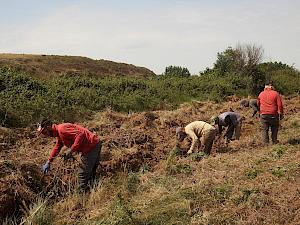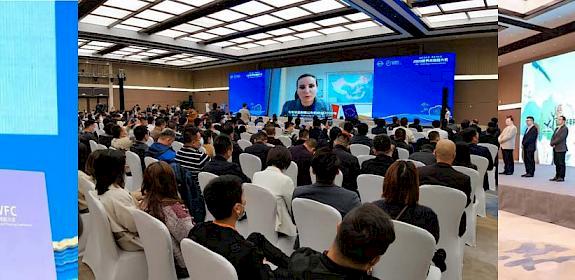TRAFFIC’s reaction to The IPBES Assessment Report on the Sustainable Use of Wild Species
The Intergovernmental Science-Policy Platform on Biodiversity and Ecosystem Services (IPBES) has released a summary for policymakers that unearths the state of the sustainable use of wild species and explains how global stakeholders can measure, strengthen and implement practices. TRAFFIC's response reiterates the need to incorporate rigorous monitoring of frameworks, increase traceability and upscale existing trade-related measures to ensure wildlife trade is legal and sustainable to ensure species survival for the benefit of people and the planet.
According to the IPBES Sustainable Use of Wild Species summary, the interconnectedness of global trade in wild species, which has expanded substantially in the last 40 years, is a significant driver of the increased and often unsustainable use of wild species. About 50,000 wild species of animals, plants and fungi are used for food, energy, medicine, material and other purposes and emphasises that the use of wild species is an intrinsic yet hidden part of everyday life that directly supports the well-being of billions of people in all regions of the world daily.
From multibillion-dollar industries to small-scale subsistence use, the health of ecosystems that supports life on earth as we know it depends on policymakers and other stakeholders taking impactful actions to secure the legal and sustainable use of wild species now.”
Richard Scobey, TRAFFIC’s Executive DirectorThe summary states that the sustainable use of wild species has “unacknowledged potential” to contribute to the achievement of many targets of the Sustainable Development Goals (SDG), such as Goals 14 (life below water) and 15 (life on land), but among others, also Goals 1 (no poverty), Goal 5 (gender equality) and 2 (zero hunger).
Currently, food security through wild plants supports one in five people globally, one-third of the global population relies on wood for cooking, and 45% of the human population relies on the use of wild species of animals, plants and fungi. If not carefully managed, this consumption can create negative feedback that exacerbates poverty, depletes resources and degrades the environment.
Understanding the drivers of use

The summary found that at current levels, scenarios point to a future where the pressures of climate change, technological advances, and increasing consumption could put untenable pressure on species.
As reflected in the recent FAO, TRAFFIC and IUCN WildCheck wild plant species report, the use of wild species is influenced by social and environmental drivers such as lack of income, food security, tradition and ever-growing demand from industry, which can drive unsustainable consumption, often unbeknownst to the companies.
Often illegal trade takes advantage of these social drivers, and as these illicit transactions are not governed by ‘institutional safeguards’ can further perpetuate the overharvesting, unsustainable trade and impacts on essential species and ecosystems. Innovative tools like SharkTrace can effectively monitor transit from source to final sale, ensuring the full traceability and sustainability of use. Such approaches to full traceability and the assurance of sustainability and legality in wild species value chains also have the potential to reduce the risks of zoonotic diseases.
“Focusing on sustainable uses and tackling social drivers at the core through targeted policies, we have the opportunity to enable growth for these vulnerable communities, turn the tide on biodiversity and ecosystem depletion, and combat illicit wildlife trade,” said Anastasiya Timoshyna, TRAFFIC’s Director of Strategy, Programme, and Impact. “But this will take a multifaceted approach from all corners of the globe; from source countries to industry and managing the demand of consumers.”
Effective monitoring is the route to success
The summary introduced seven key principles to alleviate the current and projected pressures facing the sustainable use of wild species. One of the essential elements, alongside coordinating policies and regulations, is monitoring these social and ecological drivers and practices.
In a year where experts and parties from around the globe will meet to set the path to halt biodiversity loss by 2030 through the Post-2020 Global Biodiversity Framework, it is fundamental that governments and supporting scientific bodies can robustly measure the progress on the draft Targets 5 and 9, to ensure the legal, safe and sustainable harvest, use and trade of wild species, and recognise how this will benefit local communities,” said Anastasiya Timoshyna
As a founding member of the Collaborative Partnership on Sustainable Wildlife Management (CPW), TRAFFIC and its partners continue to share their holistic knowledge of how to implement these benefits to communities, ecosystems and wild species with governments and other global stakeholders. To make this achievable, however, a robust monitoring framework, including the headline indicators for Target 5, like the one proposed by TRAFFIC, will need to be in place to effectively monitor that policies are tackling the issues and contribute to sustainable management of wildlife trade.
Once the IPBES report is completed, it will be reviewed by Convention on Biological Diversity (CBD), the Convention on International Trade in Endangered Species of Wild Fauna and Flora (CITES), among other Global Multilateral Environmental Agreements (MEAs), to bring the evidence into the work of Conventions. With a collaborative approach, TRAFFIC believes we can forge the summary’s recommendation for a ‘common vision of sustainable use and transformative change in the human-nature relationship.
Notes:
- The IPBES Sustainable Use of Wild Species summary
- [The full text for Target 5 of the Global Biodiversity Framework is still being negotiated]
- Read about a TRAFFIC collaboration project proving the unacknowledged potential of sustainable use:
The Himalayan plants supporting local livelihoods, health, and biodiversity - Representatives of almost 140 governments met in Bonn, Germany, for the ninth Plenary of the Intergovernmental Science-Policy Platform on Biodiversity and Ecosystem Services (IPBES9). The plenary approved two major new scientific reports: 'Assessment Report on the Sustainable Use of Wild Species' on 8 July and ‘Values of Biodiversity Assessment Report’ on 11 July.




